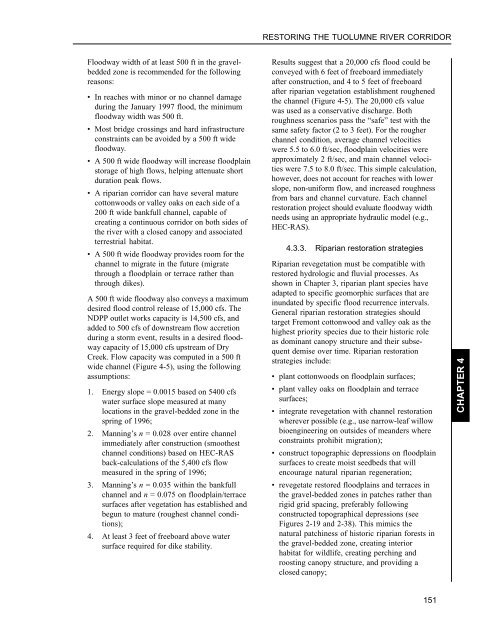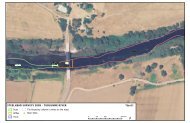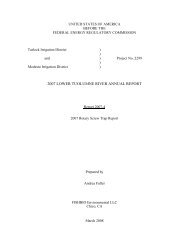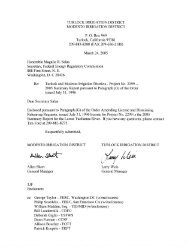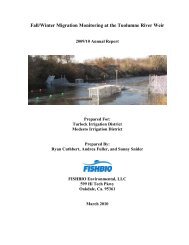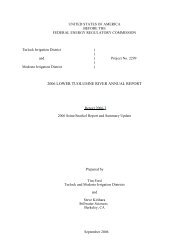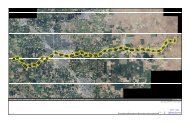Tuolumne River Report - U.S. Fish and Wildlife Service
Tuolumne River Report - U.S. Fish and Wildlife Service
Tuolumne River Report - U.S. Fish and Wildlife Service
Create successful ePaper yourself
Turn your PDF publications into a flip-book with our unique Google optimized e-Paper software.
RESTORING THE TUOLUMNE RIVER CORRIDORFloodway width of at least 500 ft in the gravelbeddedzone is recommended for the followingreasons:• In reaches with minor or no channel damageduring the January 1997 flood, the minimumfloodway width was 500 ft.• Most bridge crossings <strong>and</strong> hard infrastructureconstraints can be avoided by a 500 ft widefloodway.• A 500 ft wide floodway will increase floodplainstorage of high flows, helping attenuate shortduration peak flows.• A riparian corridor can have several maturecottonwoods or valley oaks on each side of a200 ft wide bankfull channel, capable ofcreating a continuous corridor on both sides ofthe river with a closed canopy <strong>and</strong> associatedterrestrial habitat.• A 500 ft wide floodway provides room for thechannel to migrate in the future (migratethrough a floodplain or terrace rather thanthrough dikes).A 500 ft wide floodway also conveys a maximumdesired flood control release of 15,000 cfs. TheNDPP outlet works capacity is 14,500 cfs, <strong>and</strong>added to 500 cfs of downstream flow accretionduring a storm event, results in a desired floodwaycapacity of 15,000 cfs upstream of DryCreek. Flow capacity was computed in a 500 ftwide channel (Figure 4-5), using the followingassumptions:1. Energy slope = 0.0015 based on 5400 cfswater surface slope measured at manylocations in the gravel-bedded zone in thespring of 1996;2. Manning’s n = 0.028 over entire channelimmediately after construction (smoothestchannel conditions) based on HEC-RASback-calculations of the 5,400 cfs flowmeasured in the spring of 1996;3. Manning’s n = 0.035 within the bankfullchannel <strong>and</strong> n = 0.075 on floodplain/terracesurfaces after vegetation has established <strong>and</strong>begun to mature (roughest channel conditions);4. At least 3 feet of freeboard above watersurface required for dike stability.Results suggest that a 20,000 cfs flood could beconveyed with 6 feet of freeboard immediatelyafter construction, <strong>and</strong> 4 to 5 feet of freeboardafter riparian vegetation establishment roughenedthe channel (Figure 4-5). The 20,000 cfs valuewas used as a conservative discharge. Bothroughness scenarios pass the “safe” test with thesame safety factor (2 to 3 feet). For the rougherchannel condition, average channel velocitieswere 5.5 to 6.0 ft/sec, floodplain velocities wereapproximately 2 ft/sec, <strong>and</strong> main channel velocitieswere 7.5 to 8.0 ft/sec. This simple calculation,however, does not account for reaches with lowerslope, non-uniform flow, <strong>and</strong> increased roughnessfrom bars <strong>and</strong> channel curvature. Each channelrestoration project should evaluate floodway widthneeds using an appropriate hydraulic model (e.g.,HEC-RAS).4.3.3. Riparian restoration strategiesRiparian revegetation must be compatible withrestored hydrologic <strong>and</strong> fluvial processes. Asshown in Chapter 3, riparian plant species haveadapted to specific geomorphic surfaces that areinundated by specific flood recurrence intervals.General riparian restoration strategies shouldtarget Fremont cottonwood <strong>and</strong> valley oak as thehighest priority species due to their historic roleas dominant canopy structure <strong>and</strong> their subsequentdemise over time. Riparian restorationstrategies include:• plant cottonwoods on floodplain surfaces;• plant valley oaks on floodplain <strong>and</strong> terracesurfaces;• integrate revegetation with channel restorationwherever possible (e.g., use narrow-leaf willowbioengineering on outsides of me<strong>and</strong>ers whereconstraints prohibit migration);• construct topographic depressions on floodplainsurfaces to create moist seedbeds that willencourage natural riparian regeneration;• revegetate restored floodplains <strong>and</strong> terraces inthe gravel-bedded zones in patches rather thanrigid grid spacing, preferably followingconstructed topographical depressions (seeFigures 2-19 <strong>and</strong> 2-38). This mimics thenatural patchiness of historic riparian forests inthe gravel-bedded zone, creating interiorhabitat for wildlife, creating perching <strong>and</strong>roosting canopy structure, <strong>and</strong> providing aclosed canopy;CHAPTER 4151


